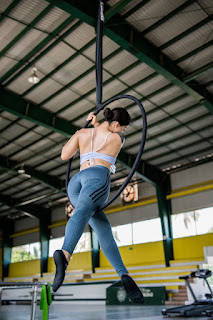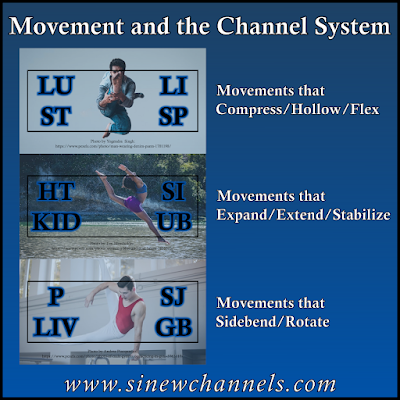The Channels Organize Movement
If you are an acupuncturist, then you learned a portion of the above image. You learned this as the circadian cycle where energy is at is peak during a 24 hour time period. You also learned various channel correspondences. For instance, the following are internally-externally related channels: LU-LI, ST-SP, HT-SI, KID-UB, P-SJ, LIV-GB. And, finally, you learned the following six divisions: Taiyang (UB-SI), Shaoyang (GB-SJ), Yangming (ST-LI), Taiyin (SP-LU), Shaoyin (KID, HT), Jueyin (LIV-P). You already know that the channels in each of the 3 grouping above share many relationships.
What you have not been taught, at least in a Chinese Medical Curriculum, is that movement is integrated around these 3 groupings. To fully understand this, you need to dive into the sinew channels (jingjin) and this is exactly what I have been exploring for the last 20+ years. This started with my interested in movement (taiji, qigong, bodyweight calisthenics), developed with my interest in fascial systems such as Anatomy Trains, and continued with exploration on approximately 100 cadaver dissections. This has led to the development of a comprehensive sinew channel model that is taught in the Sports Medicine Acupuncture Certification program where I am a faculty member.
This past Spring 2023, I presented on channels and movement at the first annual Pacific Sports and Orthopedic Acupuncture Symposium (PSOAS). The info below is a summary of this presentation and work I am continuing to develop.
The Channel Sinew Groupings & Functional Movement Patterns
.jpg) |
| Photo by Ruslan Khmelevsky: https://www.pexels.com/photo/muscular-sportsman-doing-pull-up-exercise-in-gym-4608157/ |
Other movement patterns guided by the Yangming-Shaoyin channels compress and hollow the body. They protract the scapulae, depress the chest, and flex the torso and hip. Hollow body holds, L-sits, a front kick, and many other movements fall into this category. These movements balance the expansive ones described above and there are many exercises that move back and forth between these two groupings. For instance, rowers would move back and forth between these phases; going into a compression so that they have more range as they engage the back, expand and propel forward as they pull the paddle through the water. You have to compress and load the spring before you expand, especially if you want to do it explosively. The spinal wave from White Crane qigong is another example of this ebb and flow and you can watch my video by clicking here.
 |
| Photo by Andrea Piacquadio: https://www.pexels.com/photo/photo-of-male-gymnast-practicing-on-gymnastic-rings-3763702/ |
The final grouping involves the Shaoyang and Jueyin channels which execute two very related movement patterns; sidebending and rotation. This involves trunk and neck sidebending, but also abduction and adduction of the limbs, along with rotational movements. A very simple example is in a video below where I am swinging on monkey bars. This exercise illustrates both rotation, but you will also see sidebending if you watch the video; all engagements of the Shaoyang and Jueyin channels. Note: I mention the Gallbladder sinew channel in this video, but all of the channels in this category are involved. I was simplifying since it is hard to describe these types of concepts in a video without being distracting.
 |
| Photo by Los Muertos Crew: https://www.pexels.com/photo/woman-doing-sports-at-sports-hall-10039561/ |







No comments:
Post a Comment